Leap Year 2024: Time’s Extra Day: Année bissextile’s extra day sparked global cultural rituals.

When Time Takes a Detour: Why an Extra Day Matters More Than You Think
Imagine waking up one morning and realizing that the calendar has gifted you an unexpected bonus—a whole extra day to live, breathe, and make memories. That’s exactly what happens every four years during a leap year, or as the French elegantly call it, the année bissextile. But beneath this seemingly simple addition to our calendars lies a fascinating tapestry of timekeeping precision and human culture that often goes unnoticed.
Most people glance at February 29th as a quirky anomaly—an extra day that disrupts routine, maybe even a reason for a birthday party for those born on this rare date. Yet, the leap year is far more than just an extra 24 hours. It’s a vital adjustment to keep our calendar synced with the Earth’s orbit around the Sun. Without it, our seasons would slowly drift, and over centuries, the dates for important calendar events would lose their meaning.
But what truly captivates is how this extra day has inspired diverse cultural rituals around the globe, bringing communities together in unexpected ways. From ancient Roman traditions to modern-day festivals, the année bissextile is a fascinating intersection of astronomy, history, and sociocultural expression.
Why Do We Need Leap Years? The Dance of Earth and Time
Here’s the kicker: a year isn’t exactly 365 days long—it’s approximately 365.2422 days, thanks to the Earth’s orbit around the Sun. That tiny fraction accumulates each year, and without correction, our calendar would eventually be out of sync with the seasons. Imagine celebrating Christmas in the middle of summer or planting crops in the dead of winter—that’s the kind of confusion we’d face.
Enter the leap year, the calendar’s ingenious workaround. By adding an extra day every four years, our calendar realigns with the solar year. This adjustment is the cornerstone of calendar events that mark the rhythm of our lives—holidays, agricultural cycles, and even historical commemorations depend on this accuracy.
But the leap year system itself isn’t just a simple “every four years” rule. The Gregorian calendar, which most of the world uses today, has fine-tuned this by skipping leap years on century years not divisible by 400. This meticulous system ensures extraordinary precision, proving that timekeeping is both an art and a science.
Leap Year’s Cultural Footprint: More Than Just a Date
Beyond the mechanics, the extra day of the année bissextile has sparked traditions that go far beyond astronomy textbooks:
- Marriage proposals on February 29th: In some cultures, this day flips social norms, allowing women to propose to men—a practice said to date back to the 5th century in Ireland.
- Unique birthdays: People born on the leap day often celebrate with a blend of humor and pride, acknowledging their rare birth date with special events or even legal curiosities.
- Festivals and rituals: Various communities hold special ceremonies to mark the rarity of the day, often linked to themes of renewal, luck, and even mischief.
These customs highlight how the leap year becomes a catalyst for human connection, cultural storytelling, and even social change—underscoring that timekeeping is deeply woven into the fabric of society.
What to Expect in 2024: Leap Year’s Global Stage
As 2024 approaches, anticipation builds around the next année bissextile. This isn’t just an academic curiosity; it’s a moment when millions of people worldwide partake in rituals, festivities, or simply pause to acknowledge the quirky nature of our calendar. Whether you’re a calendar enthusiast, a cultural historian, or someone with a leap day birthday, this upcoming leap year promises to be a fascinating chapter in the ongoing story of how humans reckon with time.
In the sections that follow, we’ll explore how different cultures mark this extra day, delve into the history behind the leap year concept, and offer tips on how you can make the most of February 29th in your own life. After all, an extra day is a rare gift—how will you use yours?

Leap Year 2024: Time’s Extra Day and the Global Cultural Impact of Année Bissextile
What is a Leap Year and Why Does It Occur?
A leap year is a calendar year that contains an extra day, February 29th, added to keep the calendar year synchronized with the astronomical or seasonal year. This adjustment is necessary because a solar year—the time it takes Earth to orbit the Sun—is approximately 365.2425 days long, not exactly 365 days.
Without adding this extra day every four years, calendar events would gradually drift out of alignment with the seasons, causing confusion in agriculture, religious observances, and civil planning. The term année bissextile comes from Latin, meaning "twice sixth," referring to the ancient Roman practice of counting the extra day as the "second sixth day before the Kalends of March."
How is Leap Year Calculated and Why Is 2024 a Leap Year?
Leap years follow a specific set of rules established in the Gregorian calendar, which is widely used today:
- Every year divisible by 4 is a leap year.
- However, if the year is divisible by 100, it is not a leap year unless it is also divisible by 400.
Since 2024 is divisible by 4 but not by 100, it qualifies as a leap year. This system ensures that the calendar stays accurate over long periods, minimizing drift to less than one day every 3,000 years.
What Are the Key Calendar Events and Cultural Traditions Associated with Année Bissextile?
The addition of February 29th has inspired a variety of cultural rituals and traditions around the world. These calendar events often carry special significance because the day occurs only once every four years.
Global Leap Year Traditions
- Leap Day Proposals: In Ireland and parts of the UK, February 29th is known as "Bachelor’s Day," where women traditionally propose marriage to men. This custom dates back to the 5th century and has been embraced in modern times as a playful reversal of traditional gender roles in courtship.
- Leap Year Festivals: Some cultures hold festivals or special community events on leap day, celebrating the rarity and uniqueness of the date.
- Birthday Celebrations: People born on February 29th, known as "leaplings" or "leapers," often celebrate their birthdays on February 28th or March 1st during non-leap years, while treating leap years as special milestones.
- Legal and Financial Implications: In some countries, contracts and legal documents specify how leap days are treated, affecting deadlines, interest calculations, and employee benefits.
Why Does the Extra Day Spark Global Interest and Cultural Rituals?
The rarity of the année bissextile day imbues it with symbolic meaning across cultures. It represents an "extra moment" in time, a chance to break routines, challenge norms, or celebrate uniqueness. The global fascination with leap year traditions can be attributed to:
- Human Curiosity about Time: Timekeeping has been a cornerstone of civilization. An extra day disrupts the usual flow, prompting reflection on the nature of time and calendars.
- Social Playfulness: Leap day customs often involve humor, role reversals, and festive activities that bring communities together.
- Historical Legacy: Many leap year customs have deep roots in ancient traditions, passed down and adapted over centuries, strengthening cultural identity.
How Does the Leap Year Affect Modern Society and Planning?
Beyond cultural aspects, the leap year has practical implications for modern society, technology, and global planning:
- Calendar Synchronization: Leap years ensure that calendar events like holidays, seasons, and fiscal years remain consistent over time.
- Technology Systems: Software and digital systems must account for February 29th to avoid errors in date-sensitive applications such as billing, scheduling, and data logging.
- Financial Markets: Leap years can affect interest calculations, bond maturities, and accounting periods, requiring precise adjustments.
For example, global financial services firms conduct thorough testing before leap years to ensure system stability, avoiding potential disruptions linked to the extra day.
What Are Some Interesting Facts and Statistics About Leap Years?
Understanding leap years from a data perspective sheds light on their significance:
- The Gregorian calendar was introduced in 1582 to replace the Julian calendar, which overestimated the solar year by 11 minutes, leading to seasonal drift.
- Adding the leap day approximately every four years keeps the calendar aligned to within 26 seconds of the solar year.
- Approximately 5 million people worldwide are born on leap day, making it one of the rarest birthdays.
- Some countries, like Sweden and Greece, initially had different leap year rules, causing calendar mismatches historically.
Conclusion: Embracing the Extra Day
The année bissextile and the leap year phenomenon remind us that time is a complex, human-constructed concept, shaped by astronomical realities and cultural interpretation. Leap year 2024’s extra day offers a unique opportunity to participate in global traditions, reflect on the passage of time, and appreciate the intricate dance between the Earth's orbit and our calendars.
Whether celebrating a leap day birthday, proposing marriage, or simply marking this rare calendar event, the extra day symbolizes renewal, balance, and the human desire to harmonize with nature’s rhythms.




